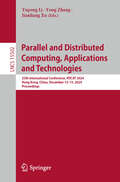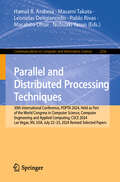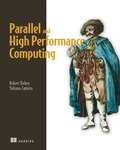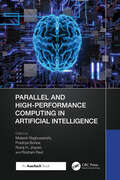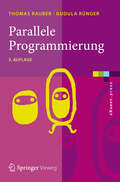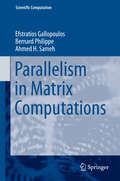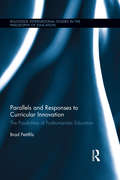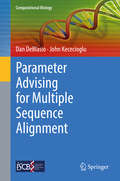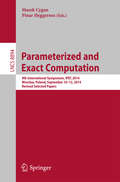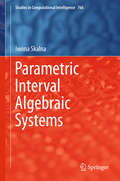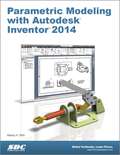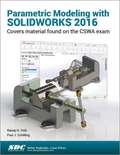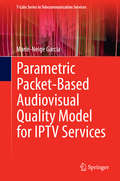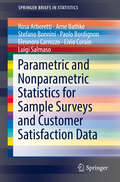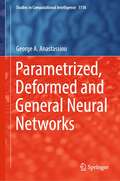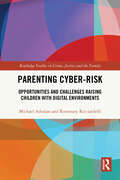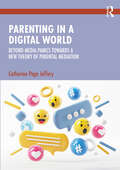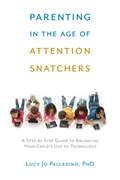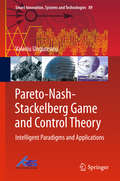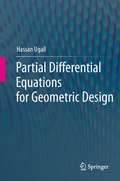- Table View
- List View
Parallel and Distributed Computing, Applications and Technologies: 25th International Conference, PDCAT 2024, Hong Kong, China, December 13–15, 2024, Proceedings (Lecture Notes in Computer Science #15502)
by Jianliang Xu Yong Zhang Yupeng LiThis book constitutes the refereed proceedings of the 25th International Conference on Parallel and Distributed Computing, Applications and Technologies, PDCAT 2024, held in Hong Kong, China, during December 14–16, 2024. The 47 full papers and 8 short papers included in this book were carefully reviewed and selected from 114 submissions. They focus on advances in parallel and distributed computing, including parallel architectures, algorithms, and programming techniques.
Parallel and Distributed Computing, Applications and Technologies: Proceedings of PDCAT 2023 (Lecture Notes in Electrical Engineering #1112)
by Hong Shen James J. Park Hiroyuki Takizawa Ji Su ParkThis book constitutes the refereed proceedings of the International Conference on Parallel and Distributed Computing, Applications and Technologies (PDCAT) which was held in Jeju, Korea in August, 2023. The papers of this volume are organized in topical sections on wired and wireless communication systems, high dimensional data representation and processing, networks and information security, computing techniques for efficient networks design, electronic circuits for communication systems.
Parallel and Distributed Processing Techniques: 30th International Conference, PDPTA 2024, Held as Part of the World Congress in Computer Science, Computer Engineering and Applied Computing, CSCE 2024, Las Vegas, NV, USA, July 22–25, 2024, Revised Selected Papers (Communications in Computer and Information Science #2256)
by Hamid R. Arabnia Leonidas Deligiannidis Masami Takata Pablo Rivas Masahito Ohue Nobuaki YasuoThis book constitutes the proceedings of the 30th International Conference on Parallel and Distributed Processing Techniques, PDPTA 2024, held as part of the 2024 World Congress in Computer Science, Computer Engineering and Applied Computing, in Las Vegas, USA, during July 22 to July 25, 2024. The 24 papers included in this book were carefully reviewed and selected from 143 submissions. They have been organized in topical sections as follows: Parallel and distributed processing techniques and applications and HPC and Workshop on Mathematical Modeling and Problem Solving.
Parallel and High Performance Computing
by Robert Robey Yuliana ZamoraParallel and High Performance Computing offers techniques guaranteed to boost your code&’s effectiveness. Summary Complex calculations, like training deep learning models or running large-scale simulations, can take an extremely long time. Efficient parallel programming can save hours—or even days—of computing time. Parallel and High Performance Computing shows you how to deliver faster run-times, greater scalability, and increased energy efficiency to your programs by mastering parallel techniques for multicore processor and GPU hardware. About the technology Write fast, powerful, energy efficient programs that scale to tackle huge volumes of data. Using parallel programming, your code spreads data processing tasks across multiple CPUs for radically better performance. With a little help, you can create software that maximizes both speed and efficiency. About the book Parallel and High Performance Computing offers techniques guaranteed to boost your code&’s effectiveness. You&’ll learn to evaluate hardware architectures and work with industry standard tools such as OpenMP and MPI. You&’ll master the data structures and algorithms best suited for high performance computing and learn techniques that save energy on handheld devices. You&’ll even run a massive tsunami simulation across a bank of GPUs. What's inside Planning a new parallel project Understanding differences in CPU and GPU architecture Addressing underperforming kernels and loops Managing applications with batch scheduling About the reader For experienced programmers proficient with a high-performance computing language like C, C++, or Fortran. About the author Robert Robey works at Los Alamos National Laboratory and has been active in the field of parallel computing for over 30 years. Yuliana Zamora is currently a PhD student and Siebel Scholar at the University of Chicago, and has lectured on programming modern hardware at numerous national conferences. Table of Contents PART 1 INTRODUCTION TO PARALLEL COMPUTING 1 Why parallel computing? 2 Planning for parallelization 3 Performance limits and profiling 4 Data design and performance models 5 Parallel algorithms and patterns PART 2 CPU: THE PARALLEL WORKHORSE 6 Vectorization: FLOPs for free 7 OpenMP that performs 8 MPI: The parallel backbone PART 3 GPUS: BUILT TO ACCELERATE 9 GPU architectures and concepts 10 GPU programming model 11 Directive-based GPU programming 12 GPU languages: Getting down to basics 13 GPU profiling and tools PART 4 HIGH PERFORMANCE COMPUTING ECOSYSTEMS 14 Affinity: Truce with the kernel 15 Batch schedulers: Bringing order to chaos 16 File operations for a parallel world 17 Tools and resources for better code
Parallel and High-Performance Computing in Artificial Intelligence (Advances in Computational Collective Intelligence)
by Roshani Raut Pradnya Borkar Rutvij H. Jhaveri Mukesh RaghuwanshiParallel and High-Performance Computing in Artificial Intelligence explores high-performance architectures for data-intensive applications as well as efficient analytical strategies to speed up data processing and applications in automation, machine learning, deep learning, healthcare, bioinformatics, natural language processing (NLP), and vision intelligence.The book’s two major themes are high-performance computing (HPC) architecture and techniques and their application in artificial intelligence. Highlights include: HPC use cases, application programming interfaces (APIs), and applications Parallelization techniques HPC for machine learning Implementation of parallel computing with AI in big data analytics HPC with AI in healthcare systems AI in industrial automation Coverage of HPC architecture and techniques includes multicore architectures, parallel-computing techniques, and APIs, as well as dependence analysis for parallel computing. The book also covers hardware acceleration techniques, including those for GPU acceleration to power big data systems.As AI is increasingly being integrated into HPC applications, the book explores emerging and practical applications in such domains as healthcare, agriculture, bioinformatics, and industrial automation. It illustrates technologies and methodologies to boost the velocity and scale of AI analysis for fast discovery. Data scientists and researchers can benefit from the book’s discussion on AI-based HPC applications that can process higher volumes of data, provide more realistic simulations, and guide more accurate predictions. The book also focuses on deep learning and edge computing methodologies with HPC and presents recent research on methodologies and applications of HPC in AI.
Parallele Programmierung
by Thomas Rauber Gudula RüngerMultiprozessor-Desktoprechner, Cluster von PCs und Innovationen wie Hyperthreading oder Multicore-Prozessoren machen parallele Rechenressourcen allgegenwärtig. Die Ausnutzung dieser Rechenleistung ist jedoch nur durch parallele Programmiertechniken möglich. Das Buch stellt diese Techniken für herkömmliche Parallelrechner und für neuartige Plattformen umfassend dar. Neben den Grundlagen der parallelen Programmierung werden Programmierumgebungen wie Pthreads, Java-Threads, OpenMP, MPI oder PVM sowie die zugehörigen Programmiermodelle behandelt.
Parallelism in Matrix Computations
by Bernard Philippe Efstratios Gallopoulos Ahmed H. SamehThis book is primarily intended as a research monograph that could also be used in graduate courses for the design of parallel algorithms in matrix computations. It assumes general but not extensive knowledge of numerical linear algebra, parallel architectures, and parallel programming paradigms. The book consists of four parts: (I) Basics; (II) Dense and Special Matrix Computations; (III) Sparse Matrix Computations; and (IV) Matrix functions and characteristics. Part I deals with parallel programming paradigms and fundamental kernels, including reordering schemes for sparse matrices. Part II is devoted to dense matrix computations such as parallel algorithms for solving linear systems, linear least squares, the symmetric algebraic eigenvalue problem, and the singular-value decomposition. It also deals with the development of parallel algorithms for special linear systems such as banded ,Vandermonde ,Toeplitz ,and block Toeplitz systems. Part III addresses sparse matrix computations: (a) the development of parallel iterative linear system solvers with emphasis on scalable preconditioners, (b) parallel schemes for obtaining a few of the extreme eigenpairs or those contained in a given interval in the spectrum of a standard or generalized symmetric eigenvalue problem, and (c) parallel methods for computing a few of the extreme singular triplets. Part IV focuses on the development of parallel algorithms for matrix functions and special characteristics such as the matrix pseudospectrum and the determinant. The book also reviews the theoretical and practical background necessary when designing these algorithms and includes an extensive bibliography that will be useful to researchers and students alike. The book brings together many existing algorithms for the fundamental matrix computations that have a proven track record of efficient implementation in terms of data locality and data transfer on state-of-the-art systems, as well as several algorithms that are presented for the first time, focusing on the opportunities for parallelism and algorithm robustness.
Parallels and Responses to Curricular Innovation: The Possibilities of Posthumanistic Education (Routledge International Studies in the Philosophy of Education #36)
by Brad PetitfilsThis volume explores two radical shifts in history and subsequent responses in curricular spaces: the move from oral to print culture during the transition between the 15th and 16th centuries and the rise of the Jesuits, and the move from print to digital culture during the transition between the 20th and 21st centuries and the rise of what the philosopher Jean Baudrillard called "hyperreality." The curricular innovation that accompanied the first shift is considered through the rise of the Society of Jesus (the Jesuits). These men created the first "global network" of education, and developed a humanistic curriculum designed to help students navigate a complicated era of the known (human-centered) and unknown (God-centered) universe. The curricular innovation that is proposed for the current shift is guided by the question: What should be the role of undergraduate education become in the 21st century? Today, the tension between the known and unknown universe is concentrated on the interrelationships between our embodied spaces and our digitally mediated ones. As a result, today’s undergraduate students should be challenged to understand how—in the objectively focused, commodified, STEM-centric landscape of higher education—the human subject is decentered by the forces of hyperreality, and in turn, how the human subject might be recentered to balance our humanness with the new realities of digital living. Therein, one finds the possibility of posthumanistic education.
Parameter Advising for Multiple Sequence Alignment
by Dan DeBlasio John KececiogluThis book develops a new approach called parameter advising for finding a parameter setting for a sequence aligner that yields a quality alignment of a given set of input sequences. In this framework, a parameter advisor is a procedure that automatically chooses a parameter setting for the input, and has two main ingredients: (a) the set of parameter choices considered by the advisor, and (b) an estimator of alignment accuracy used to rank alignments produced by the aligner. On coupling a parameter advisor with an aligner, once the advisor is trained in a learning phase, the user simply inputs sequences to align, and receives an output alignment from the aligner, where the advisor has automatically selected the parameter setting. The chapters first lay out the foundations of parameter advising, and then cover applications and extensions of advising. The content * examines formulations of parameter advising and their computational complexity, * develops methods for learning good accuracy estimators, * presents approximation algorithms for finding good sets of parameter choices, and * assesses software implementations of advising that perform well on real biological data. Also explored are applications of parameter advising to * adaptive local realignment, where advising is performed on local regions of the sequences to automatically adapt to varying mutation rates, and * ensemble alignment, where advising is applied to an ensemble of aligners to effectively yield a new aligner of higher quality than the individual aligners in the ensemble. The book concludes by offering future directions in advising research.
Parameterized and Exact Computation
by Marek Cygan Pinar HeggernesThis book constitutes the thoroughly refereed post-conference proceedings of the 9th International Symposium on Parameterized and Exact Computation, IPEC 2014, in Wroclaw, Poland, in September 2014. The 27 revised full papers presented together with one invited paper were carefully reviewed and selected from 42 submissions. The topics addressed cover research in all aspects of parameterized/exact algorithms and complexity including but are not limited to new techniques for the design and analysis of parameterized and exact algorithms, fixed-parameter tractability results; parameterized complexity theory, relationship between parameterized complexity and traditional complexity classifications; applications of parameterized and exact exponential-time computation; and implementation issues of parameterized and exact exponential-time algorithms.
Parametric Interval Algebraic Systems (Studies in Computational Intelligence #766)
by Iwona SkalnaThis self-contained book presents a framework for solving a general class of linear systems with coefficients being continuous functions of parameters varying within prescribed intervals. It also provides a comprehensive overview of the theory related to solving parametric interval linear systems and the basic properties of parametric interval matrices. In particular, it develops several new algorithms delivering sharp rigorous bounds for the solutions of such systems with full mathematical rigor. The framework employs the arithmetic of revised affine forms that enables the readers to handle dependent data. The book is intended not only for researchers interested in developing rigorous methods of numerical linear algebra, but also for engineers dealing with problems involving uncertain data. The theory discussed is also useful in various other fields of numerical analysis, in computer graphics, economics, computational geometry, computer-aided design, computer-assisted proofs, computer graphics, control theory, solving constraint satisfaction problems, and global optimization.
Parametric Modeling With Siemens NX
by Randy ShihThe primary goal of Parametric Modeling with Siemens NX is to introduce the aspects of designing with Solid Modeling and Parametric Modeling. This text is intended to be used as a practical training guide for students and professionals. This text uses Siemens NX as the modeling tool, and the chapters proceed in a pedagogical fashion to guide you from constructing basic solid models to building intelligent mechanical designs, creating multi-view drawings and assembly models. This text takes a hands-on, exercise-intensive approach to all the important Parametric Modeling techniques and concepts.
Parametric Modeling with Autodesk Inventor 2014
by Randy H. ShihParametric Modeling with Auto desk Inventor 2014 contains a series of sixteen tutorial style lessons designed to introduce Auto desk Inventor, solid modeling, and parametric modeling. It uses a hands-on, exercise-intensive approach to all the import parametric modeling techniques and concepts.
Parametric Modeling with SOLIDWORKS 2016
by Randy H. Shih Paul J. Schilling<p>Parametric Modeling with SOLIDWORKS 2016 contains a series of sixteen tutorial style lessons designed to introduce SOLIDWORKS 2016, solid modeling and parametric modeling techniques and concepts. This book introduces SOLIDWORKS 2016 on a step-by-step basis, starting with constructing basic shapes, all the way through to the creation of assembly drawings and motion analysis. <p>This book takes a hands on, exercise intensive approach to all the important Parametric Modeling techniques and concepts. Each lesson introduces a new set of commands and concepts, building on previous lessons. The lessons guide the user from constructing basic shapes to building intelligent solid models, assemblies and creating multi-view drawings. <p>This book also covers some of the more advanced features of SOLIDWORKS 2016, including how to use the SOLIDWORKS Design Library, basic motion analysis, collision detection and analysis with SimulationXpress. <p>The exercises in this book cover the performance tasks that are included on the Certified SOLIDWORKS Associate (CSWA) Examination. Reference guides located at the front of the book and in each chapter show where these performance tasks are covered.</p>
Parametric Packet-based Audiovisual Quality Model for IPTV services
by Marie-Neige GarciaThis volume presents a parametric, packet-based, comprehensive model to measure and predict the audiovisual quality of Internet Protocol Television services as it is likely to be perceived by the user. The comprehensive model is divided into three sub-models referred to as the audio model, the video model, and the audiovisual model. The audio and video models take as input a parametric description of the audiovisual processing path, and deliver distinct estimates for both the audio and video quality. These distinct estimates are eventually used as input data for the audiovisual model. This model provides an overall estimate of the perceived audiovisual quality in total. The parametric description can be used as diagnostic information. The quality estimates and diagnostic information can be practically applied to enhance network deployment and operations. Two applications come to mind in particular: Network planning and network service quality monitoring. The audio model can be used indifferently for both applications. However, two variants of the video model have been developed in order to address particular needs of the applications mentioned above. The comprehensive model covers effects due to resolution, coding, and IP-packet loss in case of RTP-type transport. The model applied to quality monitoring is standardized under the ITU-T Recommendations P. 1201 and P. 1201. 2.
Parametric and Nonparametric Statistics for Sample Surveys and Customer Satisfaction Data (SpringerBriefs in Statistics)
by Stefano Bonnini Livio Corain Luigi Salmaso Rosa Arboretti Eleonora Carrozzo Arne Bathke Paolo BordignonThis book deals with problems related to the evaluation of customer satisfaction in very different contexts and ways. Often satisfaction about a product or service is investigated through suitable surveys which try to capture the satisfaction about several partial aspects which characterize the perceived quality of that product or service. This book presents a series of statistical techniques adopted to analyze data from real situations where customer satisfaction surveys were performed.The aim is to give a simple guide of the variety of analysis that can be performed when analyzing data from sample surveys: starting from latent variable models to heterogeneity in satisfaction and also introducing some testing methods for comparing different customers. The book also discusses the construction of composite indicators including different benchmarks of satisfaction. Finally, some rank-based procedures for analyzing survey data are also shown.
Parametrized, Deformed and General Neural Networks (Studies in Computational Intelligence #1116)
by George A. AnastassiouIn this book, we introduce the parametrized, deformed and general activation function of neural networks. The parametrized activation function kills much less neurons than the original one. The asymmetry of the brain is best expressed by deformed activation functions. Along with a great variety of activation functions, general activation functions are also engaged. Thus, in this book, all presented is original work by the author given at a very general level to cover a maximum number of different kinds of neural networks: giving ordinary, fractional, fuzzy and stochastic approximations. It presents here univariate, fractional and multivariate approximations. Iterated sequential multi-layer approximations are also studied. The functions under approximation and neural networks are Banach space valued.
Parental Control: A Guide to Raising Balanced Kids in the Digital Era
by Titania JordanPractical strategies and tips to help raise and teach children in a digital-first world In Parental Control: A Guide to Raising Balanced Kids in the Digital Era, Titania Jordan, a renowned internet and social media safety specialist, tackles the urgent dilemmas of modern parenting head-on. As technology increasingly engulfs the lives of our children, this book emerges as a beacon for those looking to guide, protect, and connect with them in meaningful ways. Navigating the complex digital landscape, Jordan delves into the effects of social media and the internet on our kids. She uncovers the challenges of balancing screen time with real-life interactions and the erosion of offline social skills due to digital immersion. Yet, it's not all dire—Jordan's expert insights offer a pathway to turning potential digital pitfalls into educational opportunities. The book will help you: Learn how to educate and empower the next generation to navigate the internet safely and responsibly Discover actionable advice on setting boundaries, fostering offline interactions, and promoting healthy digital habits. Benefit from the latest internet safety data, trends, and tips to keep your children protected in the digital age Perfect for parents, educators, and caregivers, Parental Control is more than just a book. It's a roadmap to raising well-adjusted children in a technology-driven world. This guide provides the tools you need to ensure technology complements the lives of those you care about, rather than consuming them. If you're looking to navigate the challenges of modern-day parenting with confidence and create a safe, balanced digital environment for your children, then this book is for you.
Parenting Cyber-Risk: Opportunities and Challenges Raising Children with Digital Environments (Routledge Studies in Crime, Justice and the Family)
by Michael Adorjan Rosemary RicciardelliOn the back of their last book, Cyber-risk and Youth, and building on a new research project, Adorjan and Ricciardelli marshal current research to explore parenting in the digital age.Utilizing 70 original interviews from rural and urban area Canadian parents, the book provides an overview of research on “digital parenting” and illuminates the modern parental experience of managing children’s access to internet-connected technologies. The book explores parents’ experiences with cyberbullying and nonconsensual sexting, as well as concerns over breaches of privacy, screen time and internet addiction. It also investigates parents’ views regarding effective and ineffective strategies in mediation of technology and cyber-risk, including new directions such as restorative practices intended as a response to online conflict and harm. While framing their discussions among sociological theories, Adorjan and Ricciardelli also deliberately emphasize the gendered nature of the book’s discourses and encourage critical reflection of various online surveillance technologies, often marketed to mothers, to keep children safe.As such, Parenting Cyber-Risk is a standout research monograph which not only offers broad insight into 21st-century parenting challenges but also offers solutions. The book will be of interest to advanced undergraduate and postgraduate students studying criminology, sociology and any other related fields.
Parenting in a Digital World: Beyond Media Panics Towards a New Theory of Parental Mediation
by Catherine Page JefferyThis book focuses on the challenges of parenting in the digital age, providing a counter-narrative to, and critique of, risk and cyber safety narratives, as well as some suggestions for a way forward.Drawing on qualitative research with Australian families, this book explores the knowledges, practices, anxieties and lived experiences of families themselves. It demonstrates that the realities of family life in the digital age are more complex than the headlines and cyber safety advice would have us believe, as parents grapple with balancing their own anxieties and social expectations about what it means to be a ‘good’ parent, with the practices, desires, and rights of their child. It addresses key questions including: How much attention should we pay to media headlines about the dangers of contemporary media? What is actually worrying Australian parents and how do they address these concerns? Why do young people love media so much? How capable are young people of actually managing online risk? What is the right way to parent in the digital age to ensure young people’s safety and wellbeing while minimising family conflict?Aimed at media studies scholars and students, as well as parents and policy makers seeking a more comprehensive understanding of the broader academic research surrounding young people, media and parenting, this book argues that parent and child knowledges, practices and experiences must be better accounted for within the online safety ecosystem as well as in policy development, and that families need encouragement and guidance to help them adopt more democratic approaches to parenting in the digital age.
Parenting in the Age of Attention Snatchers: A Step-by-Step Guide to Balancing Child's Use of Technology
by Lucy Jo PalladinoAre your kids glued to their screens? Here is a practical, step-by-step guide that gives parents the tools to teach children, from toddlers to teens, how to gain control of their technology use. As children spend more of their time on tablets and smartphones, using apps specially engineered to capture their attention, parents are becoming concerned about the effects of so much technology use--and they feel powerless to intervene. They want their kids to be competent and competitive in their use of technology, but they also want to prevent the attention and behavioral problems that can develop from overuse.In this guide, Lucy Jo Palladino doesn't demonize technology; instead she gives parents the tools to help children understand and control their attention--and to recognize and resist when their attention is being "snatched." Palladino's straightforward, evidence-based approach applies to kids of all ages. Parents will also learn the critical difference between voluntary and involuntary attention, new findings about brain development, and what puts children at risk for attention disorders.
Pareto-Nash-Stackelberg Game and Control Theory: Intelligent Paradigms And Applications (Smart Innovation, Systems And Technologies #89)
by Valeriu UngureanuThis book presents a comprehensive new, multi-objective and integrative view on traditional game and control theories. Consisting of 15 chapters, it is divided into three parts covering noncooperative games; mixtures of simultaneous and sequential multi-objective games; and multi-agent control of Pareto-Nash-Stackelberg-type games respectively. Can multicriteria optimization, game theory and optimal control be integrated into a unique theory? Are there mathematical models and solution concepts that could constitute the basis of a new paradigm? Is there a common approach and method to solve emerging problems? The book addresses these and other related questions and problems to create the foundation for the Pareto-Nash-Stackelberg Game and Control Theory. It considers a series of simultaneous/Nash and sequential/Stackelberg games, single-criterion and multicriteria/Pareto games, combining Nash and Stackelberg game concepts and Pareto optimization, as well as a range of notions related to system control. In addition, it considers the problems of finding and representing the entire set of solutions. Intended for researches, professors, specialists, and students in the areas of game theory, operational research, applied mathematics, economics, computer science and engineering, it also serves as a textbook for various courses in these fields.
Partial Differential Equation Methods for Image Inpainting
by Carola-Bibiane SchönliebThis book is concerned with digital image processing techniques that use partial differential equations (PDE) for the task of image 'inpainting,' an artistic term for virtual image restoration or interpolation, whereby missing or occluded parts in images are completed based on information provided by intact parts. Computer graphic designers, artists and photographers have long used manual inpainting to restore damaged paintings or manipulate photographs. Today, mathematicians apply powerful methods based on PDE to automate this task. This book introduces the mathematical concept of PDE for virtual image restoration. It gives the full picture, from the first modelling steps originating in Gestalt theory and arts restoration to the analysis of resulting PDE models, numerical realisation and real world application. This broad approach also gives insight into functional analysis, variational calculus, optimisation and numerical analysis and will appeal to researchers and graduate students in mathematics with an interest in image processing and mathematical analysis.
Partial Differential Equations
by Michael Shearer Rachel LevyThis textbook provides beginning graduate students and advanced undergraduates with an accessible introduction to the rich subject of partial differential equations (PDEs). It presents a rigorous and clear explanation of the more elementary theoretical aspects of PDEs, while also drawing connections to deeper analysis and applications. The book serves as a needed bridge between basic undergraduate texts and more advanced books that require a significant background in functional analysis.Topics include first order equations and the method of characteristics, second order linear equations, wave and heat equations, Laplace and Poisson equations, and separation of variables. The book also covers fundamental solutions, Green's functions and distributions, beginning functional analysis applied to elliptic PDEs, traveling wave solutions of selected parabolic PDEs, and scalar conservation laws and systems of hyperbolic PDEs.Provides an accessible yet rigorous introduction to partial differential equationsDraws connections to advanced topics in analysisCovers applications to continuum mechanicsAn electronic solutions manual is available only to professorsAn online illustration package is available to professors
Partial Differential Equations for Geometric Design
by Hassan UgailThe subject of Partial Differential Equations (PDEs) which first emerged in the 18th century holds an exciting and special position in the applications relating to the mathematical modelling of physical phenomena. The subject of PDEs has been developed by major names in Applied Mathematics such as Euler, Legendre, Laplace and Fourier and has applications to each and every physical phenomenon known to us e.g. fluid flow, elasticity, electricity and magnetism, weather forecasting and financial modelling. This book introduces the recent developments of PDEs in the field of Geometric Design particularly for computer based design and analysis involving the geometry of physical objects. Starting from the basic theory through to the discussion of practical applications the book describes how PDEs can be used in the area of Computer Aided Design and Simulation Based Design. Extensive examples with real life applications of PDEs in the area of Geometric Design are discussed in the book.
